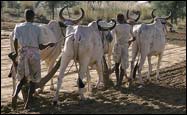New database for soil information
FAO, IIASA and partners release a new Harmonized World Soil DB
 Soil information, from global to local scale, has often been the one missing biophysical information layer, which absence added to the uncertainties of predicting potentials and constraints for food and fibre production. The lack of reliable and harmonized soil data has hampered considerably land degradation assessments, environmental impact studies and adapted sustainable land management interventions.
Soil information, from global to local scale, has often been the one missing biophysical information layer, which absence added to the uncertainties of predicting potentials and constraints for food and fibre production. The lack of reliable and harmonized soil data has hampered considerably land degradation assessments, environmental impact studies and adapted sustainable land management interventions.
 Recognizing the urgent need for improved soil information worldwide particularly in the context of the Climate Change Convention and the Kyoto Protocol for soil carbon measurements and the immediate requirement for the FAO/IIASA Global Agro-ecological Assessment study (GAEZ 2008), the Food and Agriculture Organization of the United Nations (FAO) and the International Institute for Applied Systems Analysis (IIASA) took the initiative of combining the recently collected vast volumes of regional and national updates of soil information with the information already contained within the 1:5,000,000 scale FAO-UNESCO Digital Soil Map of the World, into a new comprehensive Harmonized World Soil Database (HWSD). This state-of-the-art database was achieved in partnership with:
Recognizing the urgent need for improved soil information worldwide particularly in the context of the Climate Change Convention and the Kyoto Protocol for soil carbon measurements and the immediate requirement for the FAO/IIASA Global Agro-ecological Assessment study (GAEZ 2008), the Food and Agriculture Organization of the United Nations (FAO) and the International Institute for Applied Systems Analysis (IIASA) took the initiative of combining the recently collected vast volumes of regional and national updates of soil information with the information already contained within the 1:5,000,000 scale FAO-UNESCO Digital Soil Map of the World, into a new comprehensive Harmonized World Soil Database (HWSD). This state-of-the-art database was achieved in partnership with:
ISRIC - World Soil Information together with FAO, responsible for the development of regional soil and terrain databases and the WISE soil profile database;
- the European Soil Bureau Network, which had recently completed a major update of soil information for Europe and northern Eurasia, and
- the Institute of Soil Science, Chinese Academy of Sciences which provided the recent 1:1,000,000 scale Soil Map of China.
- The compilation of the HWSD was implemented at the International Institute for Applied Systems Analysis and verification of the new harmonized database was undertaken by all partners.
 The completion of this comprehensive harmonized soil information will improve estimation of current and future land potential productivity, help identify land and water limitations, and enhance assessing risks of land degradation, particularly soil erosion. The HWSD contributes sound scientific knowledge for planning sustainable expansion of agricultural production and for guiding policies to address emerging land competition issues concerning food, energy and biodiversity. This is of critical importance for rational natural resource management and making progress towards achieving food security and sustainable agricultural development, especially with regard to the threats of global climate change and the need for adaptation and mitigation.
The completion of this comprehensive harmonized soil information will improve estimation of current and future land potential productivity, help identify land and water limitations, and enhance assessing risks of land degradation, particularly soil erosion. The HWSD contributes sound scientific knowledge for planning sustainable expansion of agricultural production and for guiding policies to address emerging land competition issues concerning food, energy and biodiversity. This is of critical importance for rational natural resource management and making progress towards achieving food security and sustainable agricultural development, especially with regard to the threats of global climate change and the need for adaptation and mitigation.
This digitized and online accessible soil information system will allow policy makers, planners and experts to overcome some of the shortfalls of data availability to address today's pressing challenges of food production and food security and plan for new challenges of climate change, accelerated natural resources degradation, and land competition concerning food, energy and biodiversity The HWSD database is available from FAO on DVD or can be downloaded from the FAO/IIASA website
